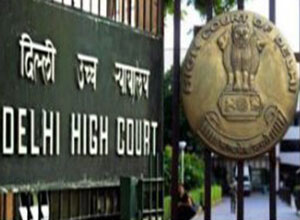Delhi HC directs Trademark Registry to devise proper mechanism for holding hearings
 In a recent case, the Delhi High Court directed the CGPDTM to device a proper mechanism for holding of hearings. The Court also enumerated the features to be incorporated in the mechanism.
In a recent case, the Delhi High Court directed the CGPDTM to device a proper mechanism for holding of hearings. The Court also enumerated the features to be incorporated in the mechanism.
Action Taken Report on Review of IPRs in India tabled before the Rajya Sabha
 The Action Taken Report by the DPIIT on the Recommendations/ Observations of the Parliamentary Committee contained in its Report on ‘Review of the Intellectual Property Rights Regime in India has been tabled before the Rajya Sabha.
The Action Taken Report by the DPIIT on the Recommendations/ Observations of the Parliamentary Committee contained in its Report on ‘Review of the Intellectual Property Rights Regime in India has been tabled before the Rajya Sabha.
Place for anonymity in trademarks? Someone tell #BANKSY!
 The applications for trademarks in India necessarily require a name and address to associate the trademark to. However, one can nevertheless provide a fake name and address in an intent-to-use application in India.
The applications for trademarks in India necessarily require a name and address to associate the trademark to. However, one can nevertheless provide a fake name and address in an intent-to-use application in India.
Lawsuit against LEGO for copyright infringement
 Are individual elements on a piece of clothing protectable owing to their “unique placement, coordination, and arrangement”?
Are individual elements on a piece of clothing protectable owing to their “unique placement, coordination, and arrangement”?
Republic of Chile joins Madrid Protocol
 On April 04, 2022, the Government of Republic of Chile deposited its instrument of accession to the Madrid Protocol with WIPO’s Director General.
On April 04, 2022, the Government of Republic of Chile deposited its instrument of accession to the Madrid Protocol with WIPO’s Director General.
Delhi HC directs Trademark Registry to devise proper mechanism for holding hearings

By Ananyaa Banerjee and Bhanu Dhingra
In a recent intrinsic order passed by the Hon’ble Delhi High Court in the case of Pawandeep Singh vs The Registrar Of Trademarks & Anr.[1], the High Court held that the application of the Petitioner in the case had been wrongly refused as refusal of a trade mark without even affording an opportunity of hearing would be contrary to the fundamental tenets of natural justice.
Brief facts of the case
The Petitioner approached the Delhi High Court aggrieved from the refusal of registration of his trademark “SWISS” in Class-17. The Petitioner alleged that he was not provided with an opportunity to be heard as he was given two hearings wherein, the official concerned did not login at both instances and hence he was denied the opportunity of being heard. The Petitioner also contended that his counsel also sent notices to the Registrar of Trademarks, however no response was received and instead a refusal order dated January 25, 2022 was issued against his trademark.
The impugned order passed by the Registrar of Trademarks stated that the petitioner was heard and thereafter the application for registration was rejected. However, it was duly admitted by the Respondent’s counsel that the Petitioner was not heard and the order was contrary to the actual facts.
Court’s order and observation
In view of the aforesaid facts and circumstances of the case, the Hon’ble Delhi High Court held that the application of the petitioner had been wrongly refused as refusal of a trade mark without even affording an opportunity of hearing would be contrary to the fundamental tenets of natural justice.
It was further noted by the Court that the permission of only three people at a time in a virtual conference was grossly insufficient and an outdated mode of conducting hearings. Further, it was held that there existed a requirement to alter the current mode by bringing in more transparency.
Delhi HC directs devising of a proper mechanism for holding hearings
Considering the gravity of the nature of the present case and the importance of following the principles of natural justice while adjudicating a case, the Hon’ble Delhi High Court directed the Controller General of Patents, Designs & Trade Marks (CGPDTM) to devise a proper mechanism for holding hearings by including the following features:
- Publication of daily cause list with serial numbers of the applications, preferably with morning and afternoon slots, as per requirement.
- Utilisation of a platform with open link so that more people can join hearings.
- Matters to be called serial number wise so that applicants do not face inconvenience by waiting in the waiting room.
- Removal of templates from order which vary from case to case (for instance, “hearing took place before me”).
- Putting extra space in the Order for Senior Examiners to record reasons for allowing or refusing an application.
The Court ordered for the placement of the proposal featuring the above point on record within two weeks and also allowed for the consultancy of the IP fraternity inclusive of but not limited to Associations like the Intellectual Property Attorney’s Association (IPAA), and the Asian Patent Attorney Association (APAA), International Association for the Protection of Intellectual Property (AIPPI), International Trademark Mark Association (INTA), or any other stakeholders, as per requirement.
The Court also set aside the impugned order dated January 25, 2022 and remanded the matter to the Trade Marks Registrar and also directed that a proper hearing has to be given to the Petitioner and orders shall be passed accordingly.
[1] W.P.(C)-IPD 7/2022 & CM 30/2022
Related Posts
Action Taken Report on Review of IPRs in India tabled before the Rajya Sabha

The “Action Taken by Government on the Recommendations/ Observations of the Committee contained in its One Hundred and Sixty First Report on ‘Review of the Intellectual Property Rights Regime in India’” was presented to the Rajya Sabha and laid on the table of Lok Sabha on April 6th, 2022.
The Review of the IPR regime in India was presented to the Rajya Sabha by the Chairman of the Department Related Parliamentary Standing Committee on Commerce on July 23, 2021.
The details of Review of the Intellectual Property Rights Regime in India (Report no. 161) can be read here.
In response to the recommendations/ observations made by the Committee, the DPIIT (Department for Promotion of Internal Trade and Industry) has also given its Action Taken Report. The 161 report as formulated by the Parliamentary Committee made several suggestions and recommendations touching on varied aspects of IPR including the necessity of IPR awareness, specifically among MSMEs and small businesses, some intrinsic amendments in the IP Acts i.e. like labelling of “Patent Pending”, amendment of Section 115 of Trademark Act, 1999 for making search and seizure procedure simply and expedited. For changes in IP Acts, the DPIIT has remarked that Stakeholders’ consultation have been taken for inclusion in Patent and Trademark Amendment Bills.
The 169th Report of the Parliamentary Committee alongwith the Action taken points by the DPIIT can be accessed here.
The Committee had considered and adopted the Report on April 05, 2022.
Related Posts
Place for anonymity in trademarks? Someone tell #BANKSY!

By Pranit Biswas and Bhanu Dhingra
One of the core tenets and the perhaps the very raison d’etre of trademarks, is to provide consumers a method to be able to choose their favorite brand over others. Logically speaking, as long as the consumer is able to point out the commodity they would like, a trademark exists. However, that logic falls flat on the fact of other legal principles and developments.
Agatha Christie is famous for her ‘Hercule Poirot’ series of books, and has her name trademarked under the Agatha Christie Foundation. However, the popular name of her book “And Then There Were None” was initially rejected as a trademark. As long as a consumer can associate her with the book, and Agatha Christie is the name that comes to mind when the trademark is used, such that usage by anyone else would be confusing, a case for trademark can be made. Applying this logic, the trademark was granted. However, Christie’s name is publicly known and widely renowned.
Banksy, a (allegedly) British anonymous artist has now lost two bids for trademark registration in the UK. Banksy is the pseudonym behind which an anonymous artist has created several world famous and widely appreciated artworks. Although Banksy successfully obtained a trademark in 2014, Full Colour Black (a company specializing in making greeting cards) brought a cancellation action claiming that Banksy wasn’t using the mark in a “genuine” manner. As a response, Banksy set up a homeware shop (Gross Domestic Product), which operated virtually to use the trademark in a “commercial” manner. His mark was cancelled nevertheless. The court opined that a trademark belongs to a business, and it should be used in commercial fashion. Using a mark as a defense against potential future infringements is not the purpose with which the intellectual property was set up. The basic economic justification for trademark protection—to lower consumers’ search costs—means that a trademark’s value is based on its commercial value.
In fact, Banksy’s own public disdain for the intellectual property came to haunt him (them), as the Court in their decision of cancellation, rather ironically stated that “By their own words, they admit that the use made of the sign was not genuine trademark use in order to create or maintain a share of the market by commercialising goods, but only to circumvent the law.”[1]. Interestingly, the Court also noted the main conundrum, which is the subject matter of this article, the issue of anonymity – “Banksy has chosen to remain anonymous and for the most part to paint graffiti on other people’s property without their permission rather than to paint it on canvases or his own property. He has also chosen to be very vocal regarding his disdain for intellectual property rights, although clearly his aversion for intellectual property rights does not annul any validly acquired rights to copyright or trademarks. It must be pointed out that another factor worthy of consideration is that he cannot be identified as the unquestionable owner of such works as his identity is hidden.” Therein lies the crux of the problem vis-à-vis intellectual property law – ownership.
Whether Banksy’s anonymity was the major factor in the denial of the trademark, or whether it was the absence of a commercial business associated with the trademark, the main takeaway in this issue was that both factors in conjunction are a death kneel to Banksy’s IP portfolio. Although Christie and Banksy are in different jurisdictions, the weight given to an Applicant’s identity was significant in both cases.
Global Perspective – Looking at the USA as a point of reference vis-à-vis anonymity
In the United States, a trademark can be anonymous, but the individual would have to register and jump through a few hoops while doing that. An individual, corporation, partnership, Limited Liability Company, or any other legal entity can be the owner of a trademark. An Anonymous LLC, which is essentially a corporation whose owners are not publicly recorded in state records, can be formed to protect an individual’s identity.
However, applications for trademarks in India necessarily require a name and address to associate the trademark to. That said, one can nevertheless provide a fake name and address in an intent-to-use application in India and try to preserve their anonymity to some degree!
However, there are no decisions yet in India, on the position of ‘anonymous trademarks’ in India.
Conclusion
The primary purpose of a trademark, is to ensure that a consumer does not get confused and the reason for being of a trademark is to serve as an effective indicator of origin. However, in cases like that one of Banksy, logically the ‘identity’ of Banksy would play a great part and one may not be able to anonymously register the likeness of a Banksy artwork as a trademark in many IP offices and objections may be raised, which the artist may not be able to overcome without resorting to associating his name and reputation with the trademark! It is indeed a proposition, which raises more questions than answers!
[1] https://www.worldtrademarkreview.com/brand-management/the-death-knell-his-portfolio-banksy-loses-another-trademark-in-bitter-ip-dispute
Also read:
Lawsuit against LEGO for copyright infringement

By Ananyaa Banerjee and Nitika Sinha
Are individual elements on a piece of clothing protectable owing to their “unique placement, coordination, and arrangement”?
LEGO has developed many branded sets over the decades, including sets inspired from popular series and movies such as Star Wars, Friends, Seinfeld, Home Alone and Harry Potter. However, its recently released “Queer Eye – The Fab 5 Loft” set based on Netflix’s Queer Eye series, has led to a copyright infringement lawsuit.
American artist James Concannon has initiated a copyright infringement action against LEGO for its alleged unauthorized copying and commercial exploitation of his work the “Concannon Jacket”. This action, which had been brought in December 2021 raises intriguing questions regarding the scale of protection of individual elements on a piece of clothing owing to their “unique placement, coordination, and arrangement”.
Concannon’s contentions:
- Concannon claims to have customized a plain black leather jacket by adding his original artwork, which was composed and arranged to reflect his signature propaganda infused aesthetic, for the famous TV personality Antoni Porowski of Netflix’s Queer Eye series in 2018.
- Concannon’s various works have been featured on the said series over the years, post his approval through release forms granting rights to display his works on the show. However, no permission was sought for exhibiting the “Concannon Jacket”, which was nonetheless, overlooked by Concannon, who took it as an oversight in light of his friendship with Antoni Porowski.
- He has argued that the “Queer Eye – The Fab 5 Loft” LEGO set is essentially a miniature version of the “Concannon Jacket” wherein LEGO has willfully copied not only the individual elements of his artistic work but also the “unique placement, coordination, and arrangement” of the said elements.
The two articles have been juxtaposed in the table given below for ease of reference:
 |
 |
 |
 |
- He has further alleged that when he reached out to LEGO to convey his concerns regarding their unauthorized use of his work, he was offered a set of the impugned “Queer Eye – The Fab 5 Loft” for free, which was later revoked by the company.
- Post this, he proceeded to send them a cease and desist letter, to which he claims that LEGO’s lawyers responded unfavorably, stating that an action against LEGO would be an “uphill battle” for Concannon as he had granted an “implied license” to Netflix to use his works, by gifting his “Concannon Jacket” to Antoni Porowski, and that this “implied license” entailed the right to sub-license the jacket to LEGO.
- Concannon has prayed for declaration of willful copyright infringement by LEGO, monetary damages, statutory damages and attorneys’ fees, among others.[i]
In addition to the above, Mr. Concannon had later also filed an amended complaint, inter alia, adding a claim of trade-dress infringement as well.
The legal battle ahead
It is pertinent to note that the US Copyright Law does not protect a useful article in its entirety, rather, just the separable creative elements. Therefore, in the present matter, the “Concannon Jacket” is in itself, not protectable, and only the individual creative elements that have been added to it may be copyrightable in respect of their “unique placement, coordination, and arrangement” as a whole.[ii]
Moreover, in the landmark case of Star Athletica, LLC v. Varsity Brands, Inc., 137 S. Ct. 1002 (2017), the Supreme Court of United States (SCOTUS), a very important principle recognized was that copyright law is ‘medium agnostic’. The applicability of the same to the present case being that whether the jacket can be conceptualized as something not completely utilitarian. In the said landmark case, the apex court had held that an artist’s designs put on cheerleading uniforms were copyrightable, and that if such designs were to be severed from the uniforms and used in another medium (such as on a notebook or a sculpture or painting), then the same would become works of art.[1]
Further, the launch of the “Queer Eye – The Fab 5 Loft” LEGO set in September, 2021 predates the Copyright Registration No.VA0002276952 dated November, 2021 which Concannon holds for the “Concannon Jacket”. This may, in effect, adversely affect his chances of being awarded statutory damages and attorneys’ fees.
While the overall look and feel of LEGO’s miniature jacket may be reminiscent of Concannon’s work, many of the individual elements contained therein are prima facie different (although, opinions as such are subjective), and Concannon would not only have to establish their copyrightability, but also that LEGO has reproduced them with a substantial similarity. Nevertheless, this lawsuit may pave a way for negotiations and possible settlement between the parties.
Mode of protection of such works in India
Keeping the facts and circumstances of this case, the topic of what other forms of IP can be used to protect such clothing items, such as the iconic designer leather jacket made by James Concannon.
In India, protection can be sought under the below regimes –
- Copyright
- Designs
From the perspective of the fashion industry, registration as a design under the Designs Act, 2000 would be the most appropriate mode of protection.
However, while a jacket like that of Mr. Concannon may be protectable under copyright, the same may be hit by 15(2) of the Copyright Act, 1957, which stipulates that Copyright in any design, which is capable of being registered under the Designs Act, 2000 (16 of 2000)] but which has not been so registered, shall cease as soon as any article to which the design has been applied has been reproduced more than fifty times by an industrial process by the owner of the copyright or, with his licence, by any other person.
In addition to the above, trademark is also a way of protecting the jacket in question, in India.
[1] https://www.lexology.com/library/detail.aspx?g=c2d7d9b9-208b-4b7a-a40b-cfd68161f414
[i] https://www.thefashionlaw.com/concannon-v-lego-system-inc-complaint/
[ii] In this regard, it is noteworthy that LEGO has successfully registered its man shape Lego as a Community trade mark.
Related Posts
COGNIZANCE OF OFFENCES UNDER SECTION 63 OF COPYRIGHT ACT
STATUTORY LICENSING UNDER COPYRIGHT LAW – SONY ENTERTAINMENT PVT. LTD. V. KAL RADIO LTD.
Republic of Chile joins Madrid Protocol

On April 04, 2022, the Government of Republic of Chile deposited its instrument of accession to the Madrid Protocol with WIPO’s Director General. The Madrid Protocol will enter into force for the Republic of Chile on July 04, 2022. By signing the accession of instrument, Chile becomes the 111th member of the Madrid system, which now covers 127 countries. Republic of Chile is the latest in the Southern cone to join the Madrid Protocol.
The Madrid Protocol is bringing the world closer together with respect to the trade opportunities and in the expansion of IP related co-operation between countries. Chile’s adoption of the Madrid Protocol, will not just help the big brand owners in Chile to take their brands to other member countries but also the local business owners like SME’s and entrepreneurs will benefit from the simple registration process of the Madrid Protocol. The local business owners in Chile could seek protection of their trademarks in territories of the other member countries through single application filed with the Chile, IP Office and payment of single set of official fees. This will help them in significantly reducing the cost and efforts during their expansion in other 110 countries.
In addition, the foreign applicants could also obtain protection for their marks by designating Chile in their Madrid Application along with other member countries. From July 04, 2022, using WIPO’s online subsequent designation service, foreign companies and trademark owners can expand their trademark protection through the Madrid system to include the consumer market of Chile. The accession of Chile to the Madrid Protocol is a positive step towards promoting trade cooperation between countries and offering a convenient/cost-effective solution for brand owners worldwide.
Related Posts

